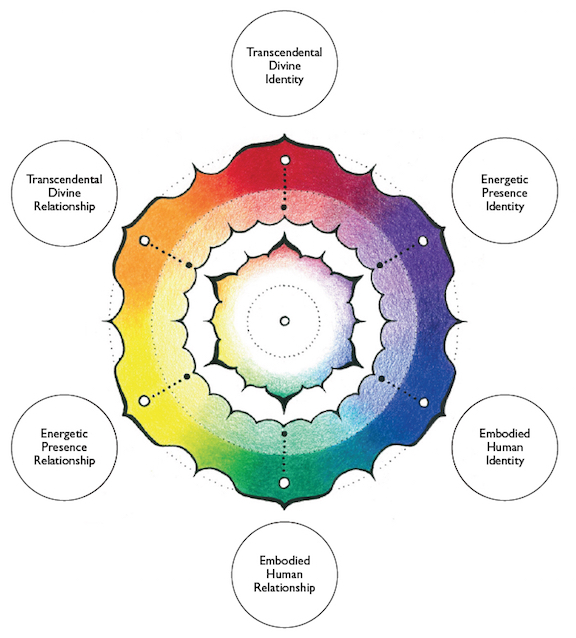
The following are excerpts from the book, “The Tapestry of Being: Talks on Practical Mysticism.” To learn more about the Tapestry Mandala and how the different color nodes relate go to : https://www.tapestryofbeing.org/the-tapestry-of-being-mandala/ and scroll down to “The Tapestry Mandala”
When I introduced this teaching, I found there were people who could see in a new way how the practices they were already naturally drawn to were serving them.

This teaching became a validation of their unique spiritual unfolding, and a means for them to understand what they could do to deepen their experience and confidence in their own inner guidance.

The sequence in which we enter into each node will be unique to each one of us. It also may be that a particular person may live their whole life in only a few of the nodes. That’s perfectly fine.

Our process can be straightforward and unforced. We move into what we are attracted to, and we may simply specialize in a few of the nodes for most of our lives.

Many of the spiritual giants in history who have made the largest contributions have been specialists who followed their passion by delving profoundly into just one or two areas. They were not necessarily “balanced” concerning these nodes. Buddha was not Rumi, and Rumi was not Buddha. Both of them specialized in their focus.

Of course, that does not mean that we cannot lean into and live all six nodes. We certainly can do so and we may indeed be drawn to do just that. Many of us will find ourselves moving around all the nodes of the Mandala quite naturally. If you find yourself thinking about what to do, the way I would suggest to do this is to follow that which attracts you.
We can use the Mandala in any way we wish, but the effect is very different when we are following our own spontaneous attraction rather than approaching it as a checklist of things to do.
For example, if we have a passion for contacting a spiritual guide, we might use the Tapestry Mandala, and find that our passion is the Yellow node: Energetic Presence Relationship.

Never having previously thought of spiritual guidance in those terms, we might see a new value in developing further in the Purple node as well: Energetic Presence Identity.

So while it didn’t seem relevant to us personally, at first, we can now see how it will serve us. We are moved into other nodes when our life takes us there—as you are moved, you quite naturally weave your tapestry.
Simultaneous and Sequential
The Mandala is an image of paradox. All of these nodes are simultaneous; they are always happening right now. Each of us has our attention distributed in each of them differently at every moment of our lives. There is no specific order or balance that is the same for everyone.
If you look at the Mandala, you are the center, and all of the nodes are the aspects of your life. In that sense, you are all of them, all of the time. Yet, attention moves through the nodes continuously.

So, the Mandala is not a developmental map that lays out which step to do next. You will move from one node to another and back again, doing your own dance, in your own way.

In this dance, even what we take as our identity and the laws of reality continue to change. Who we are is quite fluid, and distinctions between us and the environment can be different at different times. That changeability is particularly true regarding each of the Mandala nodes. Our sense of what and who we are, just as our understanding of reality, is different in each node.

The paradox of being both human and divine is only the start. It is only the beginning. The Mandala is a way to begin to be able to talk about the further paradoxes down the line.
( From The Tapestry of Being Introduction and Chapter 1: The Tapestry Mandala)
